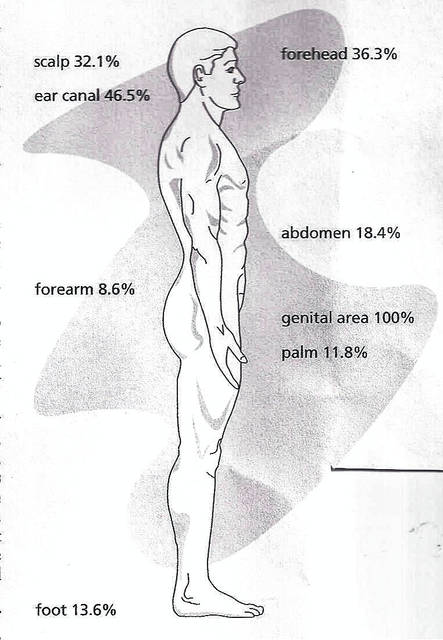
Pesticide safety is more important than ever before but I see many instances of people (farmers, homeowners and professional applicators) ignoring safety procedures in applying pesticides by wearing the wrong clothes, shoes, gloves, hats or eye protection.
The accompanying picture depicts the potential absorption of pesticides by the human body. This picture should help farmers, gardeners and others who deal with pesticides understand the danger involved if proper precautions are not taken when handling or applying pesticides.
Picture yourself on a hot summer day applying a pesticide to a fruit tree, lawn, or a growing crop like corn. When you perspire it is normal to wipe your forehead or face with a shirt sleeve or use your forearm to remove the moisture. Wait; now you have to go the bathroom and you do so without washing your hands. Look again at the picture and note the areas of your body which will absorb the most pesticide.
What are your chances of getting exposed to a pesticide without thinking? There is a lot of information on pesticide labels for our use if we read and apply the information.
This picture was taken from the 2008 National Pesticide Applicator Core Manual. Several universities including Nebraska have done similar studies.
Granular weed control products
For some reason there is a push to promote granular products as a weed control practice in home lawns. Some companies are including other ingredients in their product like soil enhancements and fertilizer. We commonly see weed control products containing 2-4-D and similar ingredients mixed in with fertilizer for applications to lawns. The idea is you can control weeds in this manner vs. spraying them.
According to Dr. David Gardener who is a weed control specialist at OSU this does not work as well as spraying the weeds with a herbicide (weed killer). The main reason is many of the granules containing weed control products fall to the soil and are not absorbed by the leaves of weeds and never make it to their roots.
The down side to spraying for weeds is the potential damage caused by spray drift on to non- target plants on your or a neighbor’s property. The best time to control perennial weeds continues to be the fall when the plants are moving nutrients to their roots. The herbicides (weed killers) are more effective than in the spring when nutrients and other chemicals are moving up and into the leaves.
A couple of good websites to help you ID weeds can be found at the Univ. of Illinois website at: http://weeds.cropsci.illinois.edu/weedid.htm and the USDA website at: http://plants.usda.gov/java/.
Always read and follow the label on all pesticides to increase your level of success and safety.
Farm Forum scholarships
Greene County Farm Forum Scholarship chair Jim Byrd has announced the following scholarship recipients for the fall of 2018. They include: Emalyn Dant is a graduate of the Greene County Career Center and plans to attend Clark State University majoring in Landscape Design. Sarah Harner is currently in her second year at the OSU Agriculture Technical Institute (ATI) at Wooster majoring in agri-business. Robert Bradley is a graduate of the Greene County Career Center and plans to attend Hocking College majoring in Wildlife Resource Management. Bradley Eakle is a graduate of Greeneview High School and plans to attend OSU ATI and major in Agri-business or Agriculture Education. Hailey Bowman is a graduate of the Greene County Career Center and will attend Sinclair Community College in the Veterinary Technician program.
Funds for the scholarship program are raised through the Annual Farm Forum Picnic/Scholarship Fund Raiser. This year’s event will be held on July 14 at the Greene County Fairgrounds in the Dining Hall. The organization has raised more than $20,000 over the past ten years to be awarded to deserving recipients studying programs in agriculture.
We Lost Iowa
According to a report from the American Farmland trust the United States lost over 31 million acres of farmland in the period of 1992-2012. To put that in perspective that is the amount of land equal to all of the farmland in Iowa. Eleven million acres were deemed to be prime farmland i.e. our best & most productive soil for growing plants.
Expanding urban areas counted for 59 percent of the loss. This report shows a loss in farmland much higher (2X) than originally thought. Farmland is important for many reasons including food production, water quality, open space, and recreation for starters.
I wonder sometimes about our annexation policies since 59 percent of the farmland loss was near urban areas. Do our planning agencies take into account the value of the land for food production or any of the other uses of rural lands? Once farmland is paved over or lost it is gone forever for most food production.
For more information on this report log on to: http://www.farmland.org/FarmsUnderThreat.


